“‘Charity Never Faileth’” Daughters in My Kingdom: The History and Work of Relief Society (2011), 61–80
“Chapter 5,” Daughters in My Kingdom, 61–80
Chapter 5
“Charity Never Faileth”
When Sister Emmeline B. Wells was called in 1910 to serve as the fifth Relief Society general president, she was prepared for the responsibility. As a participant in the migration to the Salt Lake Valley, she had worked side by side with sisters who had abiding testimonies of the gospel of Jesus Christ and who understood the foundational principles of Relief Society. She had served as secretary to two general Relief Society presidents, Zina D. H. Young and Bathsheba W. Smith, from 1888 to 1910.
With a testimony that the Relief Society had been organized by revelation, Sister Wells and her counselors, Clarissa S. Williams and Julina L. Smith, were committed to preserving the principles upon which the society had been founded. In October 1913 they said:
“We do declare it our purpose to keep intact the original name and initial spirit and purpose of this great organization, holding fast to the inspired teachings of the Prophet Joseph Smith when he revealed the plan by which women were to be empowered through the calling of the priesthood to be grouped into suitable organizations for the purpose of ministering to the sick, assisting the needy, comforting the aged, warning the unwary, and succoring the orphans.”1
A few months earlier, this sense of purpose had led Sister Wells and her counselors to establish a motto that would become a constant reminder of the organization’s founding principles and inspired origins. They chose a scriptural declaration: “Charity never faileth.”2 These three words embraced the charge that the Prophet Joseph Smith had given the Relief Society sisters: to “relieve the poor” and to “save souls.”3
In the past, pioneer women had practiced charity for close neighbors. Now Relief Society sisters would organize themselves to extend charity, “the pure love of Christ,”4 to worldwide neighbors as well.
Sister Wells and her counselors established this motto in a time of relative peace and prosperity. Little did they know how events in the coming years would put their motto to the test.
Living Peaceably in a Time of War
“Our feelings toward the world of mankind, generally, ought to be the same as Jesus manifested to them. He sought to promote their welfare, and our motto ought ever to be the same as His was—‘peace on earth and good will to men.’”
John Taylor
Teachings of Presidents of the Church: John Taylor (2001), 27; referring to Luke 2:14
War broke out in Europe in 1914. By the time the war ended in November 1918, many nations had joined the conflict, which came to be known as World War I. During this period, when bitterness and intolerance could have threatened the charitable feelings expected from Relief Society sisters, Sister Emmeline B. Wells and her counselors issued the following message to all women in the Church:
“Administer in the spirit of love and patience to your husbands and to your children; guard the little ones; do not permit them to imbibe the spirit of intolerance or hatred to any nation or to any people; keep firearms out of their hands; do not allow them to play at war nor to find amusement in imitating death in battle; inculcate the spirit of loyalty to country and flag, but help them to feel that they are soldiers of the Cross and that if they must needs take up arms in the defense of liberty, of country and homes they shall do so without rancor or bitterness. … Teach the peaceable things of the kingdom [and] look after the needy more diligently than ever.”5
In sending this message, Sister Wells urged sisters to put charity into action, just as the Prophet Joseph Smith had taught over 70 years earlier. She encouraged them to be patient with loved ones and kind toward neighbors—including enemies—and to give service to those in need. Relief Society sisters followed this counsel. They sought to receive and share the pure love of Christ, which they knew would never fail them.6 This love would sustain them through seasons of war and peace.
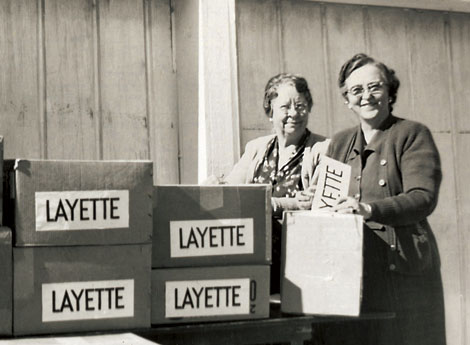
Relief Society sisters preparing layettes (sets of baby clothes) for families in need
During World War I, the Relief Society in the United States cooperated wholeheartedly with community organizations such as the National Council of Defense and the American Red Cross. The sisters participated in food production and conservation, fund drives, sanitation, child welfare work, and other service. They were effective and energetic in cooperating with these community efforts. However, their prophet reminded them that they must never lose sight of the divine origins of Relief Society.
Joseph F. Smith
Detail from Joseph F. Smith, by Albert E. Salzbrenner.
President Joseph F. Smith, the sixth President of the Church, said that while worldly organizations “are men-made, or women-made,” the Relief Society “is divinely made, divinely authorized, divinely instituted, divinely ordained of God to minister for the salvation of the souls of women and of men.” He did not want “to see the time when our Relief Societies will follow, or commingle and lose their own identity by mixing up with these woman-made organizations that are coming to pass. … It is for you,” he told Relief Society sisters, “to lead the world and to lead especially the women of the world, in everything that is praise-worthy, everything that is God-like, everything that is uplifting and that is purifying to the children of men. You are the head, not the tail.”7 Sister Emmeline B. Wells shared this vision. She guided the Relief Society in cooperating with other organizations, but she also helped maintain the society’s distinctive purpose and divine nature.
In addition to working with other organizations, Relief Society sisters did a variety of things on their own and with their wards to provide goods and raise money for those in need. Some sisters made and sold dresses, aprons, children’s clothing, quilts, and handwoven hats and rugs. Some raised and sold cattle and sheep.
A sister in Tooele, Utah, learned that a quilt she made had offered relief to a British family during the war. This Relief Society sister had made the quilt in 1906, tucked a note inside it, and sent it to San Francisco, California, to help victims of a terrible earthquake. Eleven years later, the quilt was given to the Red Cross and sent to Great Britain. When the British recipient found the note, she sent a personal thank-you letter, saying that the quilt “came in very useful, as I lost my husband at the front.” Left with eight children and no possibility of working, this widow admitted, “It is as much as I can do to keep going.”8
Many British sisters volunteered to sew and knit for the soldiers, but they had no money to buy the materials they needed. American and Canadian Relief Societies eagerly contributed to an emergency fund to help. They sent money to each branch in Great Britain so the British sisters could buy material for making sheets, pillowcases, and clothing.
When the Relief Society sold its remaining wheat to the United States government in 1918 (see chapter 4), Sister Wells observed, “In all these years we have not had much need to use the grain stored away for the purpose it was designed, but with the dark cloud hovering over the world as it now does, we can see the prophetic wisdom of President Young in calling upon the sisters to save grain against a time of need.”9
The wheat sale did more than provide food for people who were hungry. Sister Clarissa S. Williams, who served as one of Sister Wells’s counselors in the presidency, recommended that the Relief Society preserve the funds from the sale in a central account and that they use the interest to finance efforts to improve the health of women and children. Later, when Sister Williams served as the sixth Relief Society general president, she oversaw the use of those funds for such purposes.
Strengthening Individuals and Families
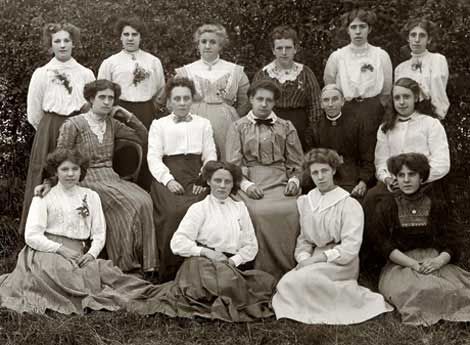
Relief Society sisters in Kidderminster, England
At the end of World War I, many families and individuals were in need—financially, physically, emotionally, and spiritually. To meet these needs, the Relief Society established the Relief Society Social Service Department in 1919, with the full support of President Heber J. Grant, the seventh President of the Church. Sister Amy Brown Lyman, who later became the eighth Relief Society general president, served as the director of the department. Through the Social Service Department, the Relief Society cooperated with wards and stakes in efforts such as helping needy women and girls find employment and placing children for adoption. Its primary purpose, however, was to provide practical training for families. Sister Lyman said that the Relief Society Social Service Department was not a “relief-giving agency” but a “service department,” emphasizing “the study of family situations, the making of plans and budgets, the organizing of relief where LDS families [are] concerned, and the training of workers.”10
With this goal in mind, the Social Service Department created a six-week training program in family welfare. Stake workers took this class and then went back to their wards and communities and taught it. Over 4,000 women were trained.
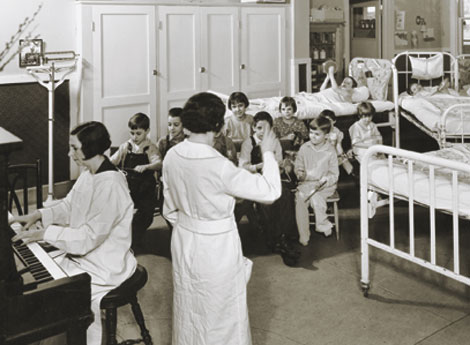
Nurses and children enjoying music at LDS Hospital in Salt Lake City, Utah, 1934
Beginning in 1902, the Relief Society general presidency had sponsored a program for training nurses. By 1920, professional training for nurses had become more extensive, so the Relief Society established a training program for nurses’ aides. This one-year course, which began at LDS Hospital in Salt Lake City, Utah, did not charge tuition. Instead, the students were required to give 30 days of free nursing service in their communities. After 4 years, in which 46 aides were trained, the Relief Society discontinued the program and transferred their support to Red Cross home-nursing courses. As with some other programs, the Relief Society used this program to meet a specific temporal need of the time and then turned the work over to other agencies.
Relief Society leaders encouraged sisters to continue serving one another in charitable ways, as they had done from the beginning days in Nauvoo. Sisters cared for the sick, sewed for those who needed clothing, and gave relief in other ways to those in need. For example, in 1921 a group of Armenian Latter-day Saints living in Turkey had to evacuate their homes. Joseph W. Booth, the president of the Palestine-Syrian Mission, helped them move to Aleppo, Syria, where he organized a branch with a Relief Society of about 30 sisters. Most of these women were very poor, and yet they felt it was their privilege and duty as Relief Society women to serve those who were less fortunate than they. So they gathered together and sewed clothing from 100 yards of cloth that President Booth had purchased. They also prepared a meal for undernourished fellow refugees.
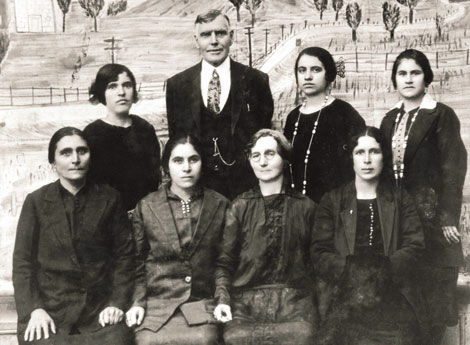
Joseph W. Booth and Relief Society sisters from Armenia in the early 1920s
In April 1921, Sister Clarissa S. Williams succeeded Sister Emmeline B. Wells as Relief Society general president. Having served in the presidency with Sister Wells, she was ready for the challenges that would come. She was known for her organizational skills and her love and friendship to all.
Sister Williams was concerned about the high mortality rate of mothers and infants. She was also concerned about the lack of opportunities for the disabled and the low standard of living for many women. Under her wise and able leadership, Relief Societies continued their efforts to alleviate these problems. In 1924, with support and encouragement from general and local priesthood leaders and Sister Williams, the Cottonwood Stake Relief Society established a maternity hospital. This hospital later became part of a network of Church hospitals.
Sister Williams saw a great need for advancement in “health, opportunity, and a decent standard of living for all those with whom we come in contact.” She said, “Such an undertaking for general betterment comprehends careful preparation, training, educational work, and actual service.”11 These efforts helped meet present demands, giving bishops an avenue for providing assistance for needy families. They also prepared the Church to respond to difficulties that would come a few years later.
Cultivating Self-Reliance
“We … urge, earnestly and always upon the people, the paramount necessity of living righteously; of avoiding extravagance; of cultivating habits of thrift, economy, and industry; of living strictly within their incomes; and of laying aside something, however small the amount may be, for the times of greater stress that may come to us.”
First Presidency (Heber J. Grant, Anthony W. Ivins, J. Reuben Clark Jr.)
Deseret News, Sept. 2, 1933, Church section, 7; punctuation standardized
For more than a decade after World War I, the Relief Society worked to improve the standard of living for women and families, focusing on health, jobs, and education. The Relief Society also continued to encourage personal righteousness and acts of charity. Then, with little warning, the world plunged into a great economic depression at the end of 1929.
Once again the qualities taught and learned in Relief Society strengthened individuals and families in a time of crisis. Latter-day Saint women found strength in their faith in Heavenly Father and Jesus Christ, drew on their skills of self-reliance, and worked to express the charity in their hearts. With these principles to guide them, they were able to take care of themselves and their families while reaching out to others.
In 1928, President Heber J. Grant called Sister Louise Y. Robison to serve as the seventh Relief Society general president. Economic challenges were not new to Sister Robison. She had grown up in a humble log home in rural Scipio, Utah, where she had learned to farm, garden, sew, work hard, live on little, and be of good cheer.
Seven years before calling Sister Robison to be Relief Society general president, President Grant had set her apart to serve as second counselor in the general Relief Society presidency. She had felt her inadequacies keenly, as her daughter recounted:
Heber J. Grant
Detail from Heber J. Grant, by C. J. Fox. © IRI.
“When Mother went to President Grant’s office to be set apart, she felt sure he had been misinformed about her abilities, so she told him she’d be happy to do her best in whatever he asked her to do, but she wanted him to know that she had a limited education, and very little money and social position, and she was afraid she wouldn’t be the example that the women of the Relief Society would expect in a leader. She finished by saying ‘I’m just a humble woman!’ President Grant answered, ‘Sister Louizy, 85% of the women of our Church are humble women. We are calling you to be the leader of them.’”12
Encouraged by President Grant’s words, Sister Robison shared her unique gifts and served wholeheartedly, first as a counselor and then as president. She was wise, compassionate, and hardworking. Her lack of formal education and material wealth enabled her to understand and help those in similar circumstances. Her advice to homemakers and mothers was practical and empathetic. She understood the struggle to live on a meager budget, and yet she knew the importance of a mother’s influence in the home. So she encouraged mothers to do all they could to stay at home with their children rather than leave them for the workplace.
The United States government established many relief programs to try to turn the tide on the economic crisis. For a time, the Relief Society Social Service Department worked with these community agencies to serve needy families, but needs grew beyond the capacity of the department to handle. One worker in the department saw her caseload grow from 78 families in 1929 to more than 700 in 1934.13
The Church appreciated the efforts of government agencies. Sister Robison said that the United States government was “doing a wonderful thing” in helping people in need. However, she joined with priesthood leaders in saying that Church members needed to continue to foster fundamental values of self-sufficiency. She said: “For ninety-three years Relief Society has been saying that we take care of our needy ones. I wonder if we are leaving it too much to the Government now.”14
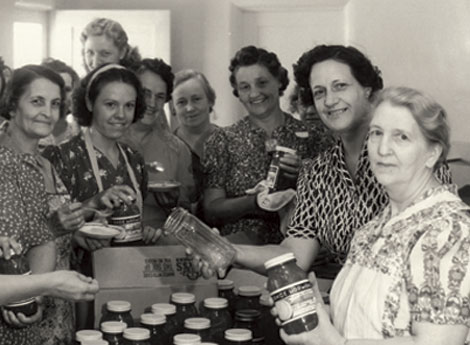
Relief Society sisters in California preserving food for their stake’s welfare program, about 1940
In April 1936, the First Presidency introduced a Churchwide welfare program. This put the Church in a better position to help needy members. In the October 1936 general conference, President Heber J. Grant explained the purpose of the program.
“Our primary purpose,” he said, “was to set up, in so far as it might be possible, a system under which the curse of idleness would be done away with, the evils of a dole abolished, and independence, industry, thrift and self respect be once more established amongst our people. The aim of the Church is to help the people to help themselves. Work is to be re-enthroned as the ruling principle of the lives of our Church membership.”15
Years later, President Thomas S. Monson, the sixteenth President of the Church, echoed this teaching. “Remember,” he said, “Church assistance is designed to help people help themselves. The rehabilitation of members is the responsibility of the individual and the family, aided by the priesthood quorum and Relief Society. We are attempting to develop independence, not dependence. The bishop seeks to build integrity, self-respect, dignity, and soundness of character in each person assisted, leading to complete self-sufficiency.”16
One of the guiding principles of the welfare program was that Relief Society sisters and priesthood brethren should work in harmony. President Harold B. Lee, the eleventh President of the Church, helped establish the welfare program when he was serving as a stake president. He said:
“The most important object that is to be achieved by [the Church welfare program] is the promoting of a spirit of cooperation and unity throughout the entire Church. …
“To the extent that Relief Society Organizations in Wards are operating in cooperation with Priesthood Quorums and Bishoprics, just to that extent is there a [welfare] program in that ward.”17
The role of the ward Relief Society president was especially important, said Bishop Joseph L. Wirthlin, then the Presiding Bishop of the Church: “To my way of thinking, there is only one individual who can go into a home, analyze its needs, and supply them wisely. That individual is one we may choose to call a home manager, a Relief Society president. … After all, these splendid women have homes of their own, have gone through the experiences related to motherhood and the management of homes.”18

A gathering of Relief Society sisters in Del Rio, Texas, about 1950
Relief Societies were well positioned to take a prominent role in ward welfare efforts. Under the direction of bishops, they appraised the needs of families and then provided dried and preserved fruits and vegetables, clothing, and bedding as needed. For a time, sisters who bottled fruit were asked to give up every tenth jar to the welfare program. Sister Belle S. Spafford, the ninth Relief Society general president, remembered gathering fruit that the wind had blown to the ground, preserving it in bottles, and giving it to sisters in need. Through this opportunity for service, she gained a greater appreciation for the purpose of Relief Society.
Relief Society leaders were an integral part of the Church welfare system. On the general, stake, and ward levels, they participated in welfare committee meetings, and they influenced decisions and coordinated efforts. This coordination was essential as the Church’s welfare system of farms, factories, distribution centers, and other physical facilities grew. The Relief Society Social Service Department was incorporated into Church Welfare and Social Services in 1969.
Strengthening the Bonds of Charity
From 1939 to 1945, World War II engulfed much of the world. Most of the Church’s programs were affected by this global conflict. In March 1940, President J. Reuben Clark Jr., First Counselor to President Heber J. Grant, met with auxiliary presidents to reexamine all programs and activities. They outlined four basic aims for each arm of the Church: “to curtail the ‘evermounting burden’ on members of sustaining church activities, to lessen the bishops’ burdens, to cut programs that required large, expensive meetinghouses, and to keep the Church within its income.” The Relief Society and other organizations were asked to “consolidate, cooperate, eliminate, simplify, and adjust their work so as to cooperate with the [First] Presidency in reaching the aims above indicated.”19
Safeguarding the Family
Church leaders’ primary purpose for simplifying their programs was to safeguard the family. Priesthood and auxiliary leaders were concerned that World War II was fragmenting homes and families. As men went to war, women had to sustain their families without immediate help from their husbands and older sons. Church leaders again encouraged mothers with children at home to find ways, if possible, to provide for the children without working outside the home full-time. These leaders encouraged Relief Society sisters to develop foundational skills of self-reliance: quilting, sewing clothing, growing gardens, and preserving and storing fruits and vegetables. They also emphasized the mother’s spiritual role in the home. Nations torn by war needed good young citizens who learned lessons of morality and uprightness from their mothers.
Collaborating with Community Organizations and Priesthood Brethren
As in the previous world war, Relief Society members in the United States answered a call to volunteer and to support the efforts of other worthy organizations. In 1942, more than 10,000 Relief Society sisters completed Red Cross courses in home nursing, first aid, and nutrition. Also, the Church advocated anti-tobacco and anti-liquor campaigns to protect the health of Latter-day Saints serving in the military. Through their support of these programs and through their compassionate, charitable service, Relief Society sisters promoted good health and goodwill.
This was a time of much collaboration for Relief Society sisters, both in the community and with priesthood leaders. Sister Amy Brown Lyman, who served as the eighth Relief Society general president during most of World War II, said:
“I think that one of the things that I have appreciated as much as anything … is the support that the Relief Society women have always received from the priesthood—from the General Authorities of the Church and also from the local priesthood as well, especially from the ward bishops.
“The General Authorities have given the Mormon women leaders of the auxiliary organizations not only exceptional opportunities within the Church, but they have encouraged them in their cooperative work with other humanitarian agencies.”20
One example of this cooperation was the Indian student placement program, which began in 1947 with the support of Elder Spencer W. Kimball, then of the Quorum of the Twelve Apostles. Through this program, American Indian youth from small communities accepted invitations to live for a time with Latter-day Saint families in places where formal education was readily available and where the Church was well established. The program encouraged these youth to expand their experiences, and it also promoted understanding between different cultures.
Relief Society leaders, especially Sister Belle S. Spafford, the ninth Relief Society general president, helped administer the program under the direction of Elder Kimball. Many sisters served the youth directly by nurturing them as if they were their own children. The program continued until 1996. President Boyd K. Packer of the Quorum of the Twelve Apostles later observed: “The Indian Placement program filled its purpose, and it has been disbanded. And that happens. … We take the scaffolding down when construction is complete.”21
“The Pure Love of Christ”: Charity in Action
“Our eternal happiness will be in proportion to the way that we devote ourselves to helping others.”
George Albert Smith
In Conference Report, Oct. 1936, 71
Relief Society sisters in Europe experienced great devastation from World War II. They also demonstrated praiseworthy courage in serving one another in spite of harrowing conditions. They continued faithful and relied on their testimonies and the Atonement of Jesus Christ. Their lives and testimonies from this period are truly inspiring.
After the war, Maria Speidel, who served as the president of the Germany Stuttgart District Relief Society, wrote:
“The past five years have been difficult ones and we have become very humble. Our trust in the Lord and our testimony of his Church have been our pillar of strength. He has kept us mercifully, and although there was much to suffer, he has given to us a measure of his strength. Some of us have lost all our earthly possessions, every tangible thing ever dear to us, and when we say ‘It is better to walk with God in the darkness than without him in the light,’ we know whereof we speak. …
“… With joy we sing the songs of Zion and put our trust in the Lord. He maketh all things well.”22
Gertrude Zippro, another district Relief Society president, walked with God in the darkness many nights to love and serve her sisters. She lived in Holland at a time when the country was under military occupation. Because guards often stopped and searched travelers, she carried identification with her so she could visit branch Relief Societies in the district.
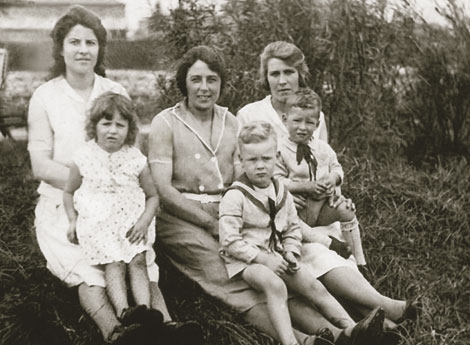
Gertrude Zippro, center, with her sisters and children
Sister Zippro’s son John said that it “became increasingly dangerous to be out at night as the occupation continued for five years.” Remembering his mother’s dedication, he said, “Can you imagine my mother braving those circumstances and going out at night on her bike many times, to visit another branch?” He recalled: “No matter how she felt or what the circumstances, she would take care of her obligation. What a great woman and leader she was! There is no doubt in my mind now that she was hand-picked by the Lord to be the Relief Society President at that time.”
Sister Zippro’s son observed, “She must have had complete trust in the Lord to go time after time under those conditions, not knowing what problems she would encounter.”23
In Denmark, the Saints’ situation was more tolerable than in many other countries. Food was available to them, so they shared it with their less-fortunate neighbors. Eva M. Gregersen, president of the Danish Mission Relief Society, said: “We have during the war taken up the work of helping our starving brother-land, Norway. Together with the mission office, we have been giving money to this purpose and every month many nice packages with food have been sent to our brothers and sisters in Norway, who have been thankful beyond words.”24
President Hugh B. Brown was a firsthand witness of such charity. He served as president of the British Mission from 1937 to 1939, as coordinator for Latter-day Saint servicemen in Europe from 1939 to 1945, and again as president of the British Mission from 1945 to 1946. He later served as a member of the Quorum of the Twelve Apostles and the First Presidency. He reported on the service he saw among Relief Society sisters during World War II:
“There are hundreds of Relief Society women in the war zone who have been exposed to dangers, trials and hardships, comparable to that which our men undergo in the battle field. These brave women have carried on in the face of almost insuperable difficulties. …
“To kneel in prayer with these women and to hear them thank God for their simple blessings, for the preservation of their lives and the lives of their loved ones, and for their scanty provisions and their windowless homes is at once an inspiration and a reproof to many of us whose material blessings far exceed any enjoyed here, but who frequently complain at being deprived of a few luxuries.”25
Hedwig Biereichel, a sister in East Germany, provided food for starving Russian prisoners of war, even though she and her family could have been imprisoned or shot for such an act of charity.26 Years later, she was interviewed about her experiences, as were several others who had endured similar trials during World War II. At the end of each interview, the interviewer asked, “How did you keep a testimony during all these trials?” The interviewer summarized all the responses she received with this statement: “I didn’t keep a testimony through those times—the testimony kept me.”27
When World War II ended in 1945, Relief Society sisters worldwide had suffered much sorrow and deprivation. Through it all, however, they had continued to serve one another, strengthen families, and bolster testimonies.
As a witness of so much suffering and so much selfless service, Sister Amy Brown Lyman declared:
“[My] testimony has been my anchor and my stay, my satisfaction in times of joy and gladness, my comfort in times of sorrow and discouragement. …
“I am grateful for the opportunity I have had of serving … in the Relief Society where during most of my mature life I have worked so happily and contentedly with its thousands of members. I have visited in their homes, slept in their beds, and eaten at their tables, and have thus learned of their beauty of character, their unselfishness, their understanding hearts, their faithfulness, and their sacrifices. I honor beyond my power of expression this great sisterhood of service.”28

“Charity is the pure love of Christ, and it endureth forever” (Moroni 7:47).
Detail from Christ Healing a Blind Man, by Del Parson. © 1983 IRI.
In times of trial and uncertainty, Relief Society sisters worldwide have followed Mormon’s admonition to “cleave unto charity, which is the greatest of all.” They have demonstrated their sure understanding that while “all things must fail … charity is the pure love of Christ, and it endureth forever.”29 Time and time again, they have been true to their motto: “Charity never faileth.”